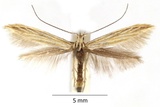Coleophora trochilella (Duponchel, 1843) Species
Last modified: Dec. 20, 2024, 3:26 p.m.
A very rare species in Belgium, but as with many others probably overlooked. The search for the cases after 2004 gives us a better look at the distribution of this species.
Details
- Classification
- Family: Coleophoridae > Genus: Coleophora > Species: Coleophora trochilella
- Vernacular names
- Gestreepte bijvoetkokermot (NL), Verge case-bearer (EN)
- Synonyms
- Coleophora troglodytella sensu auct. and Coleophora ramosella sensu auct., nec Zeller, 1849
- First mention in Belgium
- De Fré Ch. 1860. Lépidoptères nouvellement découverts en Belgique. — Annales de la Société entomologique belge 4: 113–115. On page 114 (as Coleophora ramosella. Zell.). view page
- Status
-
Native
Distribution
Case
A straw-colored, slender, three-valved case of the type “tubular silken case”; length about 10 mm, mouth angle 45°–60°.
See also bladmineerders.be.
Mine
The caterpillars make a lot of spinning where the tubes are secured. This creates holes with a striking white edge.
Bionomics
The eggs are deposited at the underside of a leaf with cases found most of the time here. Cases can be found from August till June of the following year with larvae fully fed in June.
This species prefers mostly sandy soil.
The adults come to light.
Flight periods
The adults fly in one generation a year from late June till mid-August.
Observed on
- Host plant (species):
- Artemisia vulgaris and Achillea millefolium
- Host plant (genera):
- Achillea, Eupatorium, Tanacetum, Carduus, Inula and Leucanthemum
The larva feeds mainly on Achillea millefolium and Artemisia vulgaris but is also reported on Carduus, Inula and Leucanthemum.



